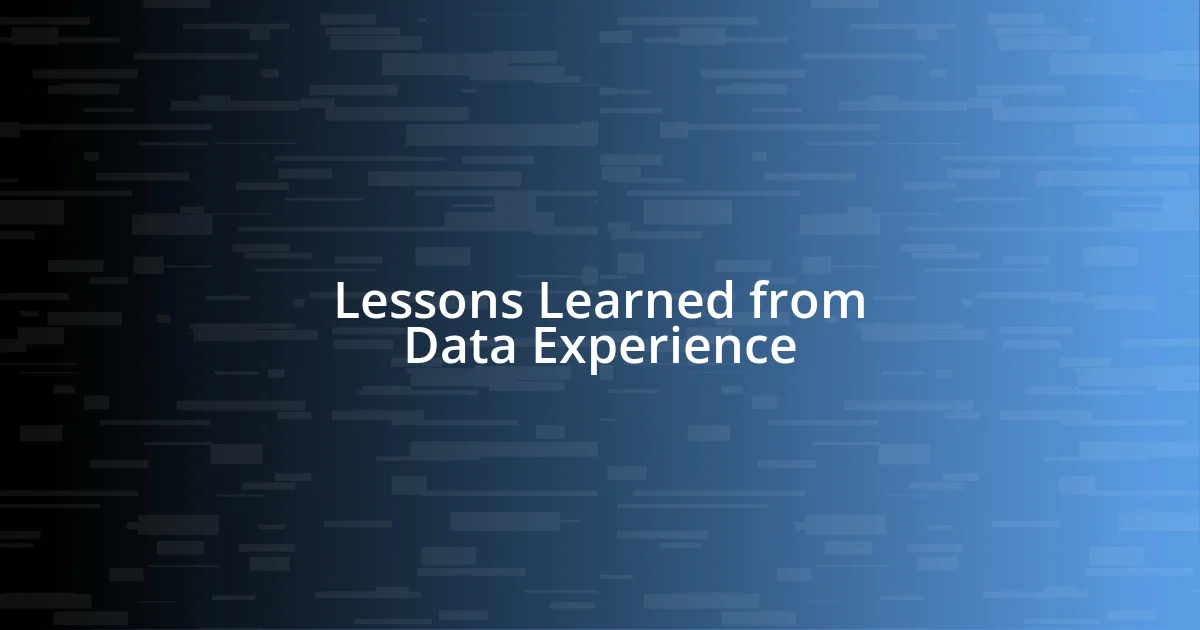Key takeaways:
- Data-driven decisions can unveil patterns and opportunities, blending analytics with intuition for impactful results.
- Using tools like Excel and Google Analytics enhances data analysis and presentation, fostering collaboration and clarity among teams.
- Embracing unpredictability in data interpretation and the importance of context leads to more accurate insights and continuous personal growth in analysis skills.

Understanding Data-Driven Decisions
Data-driven decisions are all about leveraging insights from data to guide choices effectively. I remember a time when I was tasked with improving a product line. By diving deep into customer feedback and sales data, I realized that certain features were underappreciated by users, leading us to pivot our strategy. Isn’t it fascinating how numbers can shape our understanding of customer desires?
In my experience, the real magic of data-driven decisions lies in their ability to reveal patterns we might overlook. For instance, I once analyzed marketing campaign results and discovered that a particular audience segment engaged significantly more with our content. This was an eye-opening moment! It sparked a whole new approach to targeting, proving that data can sometimes unveil opportunities we might otherwise miss.
However, it’s essential to remember that data should complement, not replace, our intuition and creativity. I’ve often found myself asking, “What do these numbers really tell us?” While data provides a foundation, the emotional connection we have with our audience is what ultimately guides meaningful decision-making. Have you ever experienced that blend of analytics and instinct? It’s a powerful synergy that can lead to truly impactful outcomes.

Importance of Data in Business
Data serves as the backbone of effective business strategies today. When I first started analyzing project performance metrics, I was astounded by how numbers could unveil operational inefficiencies. For instance, an analysis of turnaround times led us to reassess our workflow, ultimately slashing project completion times by 20%. The insights gained from data aren’t just numbers; they tell a vivid story about where we can improve.
One memorable experience involved a customer satisfaction survey I spearheaded. The collected data illuminated key pain points that our team hadn’t previously acknowledged. This revelation prompted immediate changes in our service protocols. It felt empowering to see the direct impact of data on enhancing customer relationships, turning dissatisfied clients into loyal advocates. Have you ever made a decision based on an unexpected data point? I can tell you, that moment of clarity is exhilarating.
Moreover, embracing data fosters a culture of accountability within teams. I recall a project where we set clear KPIs based on historical data. Every team member understood their role in achieving those targets, creating a sense of ownership and motivation. In my experience, when data drives our objectives, it not only clarifies goals but also inspires collaboration. Can you imagine the energy this creates among colleagues? It’s truly remarkable how data can bond teams through shared aspirations.
| Aspect | Traditional Decision-Making | Data-Driven Decision-Making |
|---|---|---|
| Basis | Intuition and gut feelings | Quantitative analysis and insights |
| Flexibility | Reactive adjustments | Proactive strategy development |

My Initial Experience with Data
When I first encountered data during a project at my previous job, it felt like stepping into a new world. I remember grappling with spreadsheets filled with numbers and trying to decipher patterns that felt elusive at best. The breakthrough came when I stumbled upon a specific trend in customer purchasing habits, which opened my eyes to a realm of possibilities. The surprise of finding these insights ignited my passion for data analysis, proving that numbers can tell stories that resonate deeply with our business strategies.
- My first significant project involved analyzing customer retention rates.
- I felt overwhelmed by the volume of data but excited to uncover hidden insights.
- The moment I identified a drop-off point in the customer journey was electrifying.
- This revelation shifted our focus and ultimately improved our retention strategy.
I’d often find myself reflecting on how this journey with data has shaped my approach to problem-solving. Initially, data felt intimidating, but with each analysis, I built confidence and curiosity. A vivid experience was when I presented findings to the team; it was nerve-wracking yet thrilling to share insights that could lead to tangible changes. The palpable energy in the room when I shared those revelations? Unforgettable!

Tools for Analyzing Data
When it comes to analyzing data, I’ve found that utilizing the right tools can dramatically influence your results. For example, I absolutely love using Excel for its versatility. Initially, I thought its capabilities were limited to basic calculations, but I was amazed to discover advanced functions like PivotTables and VLOOKUP. These features helped me to slice and dice data effortlessly, revealing patterns that I wouldn’t have noticed otherwise. Have you ever had an “aha” moment while working through data? That feeling of connection to the numbers can spark creativity in how you approach problems.
In addition to Excel, I’ve dabbled with data visualization tools like Tableau. I remember the first time I created a dashboard that visually represented sales trends over the year. It felt like magic! Suddenly, complicated data transformed into an accessible story. What struck me was how easily I could share these visual insights with my team, making the data not just something to analyze, but something captivating to discuss. Seeing the lightbulb go off for my colleagues was a gratifying experience that reaffirmed the importance of clarity in data presentation.
Another tool that has made a significant impact in my analysis journey is Google Analytics. As I navigated its various features, I learned to track user behavior on our website—this was a game-changer! When I first linked our marketing campaigns to specific user actions, the insights were eye-opening. It prompted discussions about our content strategy, and we quickly adapted based on real-time user data. Isn’t it fascinating how accessible this information is now? The immediacy of data allows for quick adjustments, and it feels empowering to know that with a few clicks, I can deeply inform our marketing strategies.

Challenges I Faced in Analysis
Facing challenges during data analysis has been a particularly enlightening experience for me. One of the most significant hurdles was dealing with incomplete data. I remember a project where vital information was simply missing, which made drawing clear conclusions nearly impossible. Have you ever found yourself piecing together a puzzle with missing parts? It’s frustrating and often leads to uncertainty about the results.
Another challenge I encountered was data overload. I had a mountain of information but felt lost in the sea of numbers and metrics. I vividly recall an instance when I was trying to analyze a complex dataset. It took me hours to realize that sometimes, less truly is more. By focusing on key metrics rather than trying to analyze everything, I was able to produce insights that were not only actionable but truly impactful. It’s incredible how scaling back can often clarify the path forward.
Lastly, I struggled with translating my findings into language that was accessible for non-technical team members. Once, after spending days sifting through data, I confidently presented my results, only to see bewildered expressions on my colleagues’ faces. That moment was a turning point for me; I learned that effective communication is just as crucial as analysis. Have you ever tried explaining something complex and felt like you were speaking a different language? It was an eye-opener and motivated me to hone my storytelling skills when presenting data.

Strategies for Effective Decision Making
When it comes to effective decision-making, I’ve learned that setting clear objectives is essential. I distinctly remember a time when my team faced a crossroads in a major project. We gathered and outlined our goals, ensuring everyone was aligned. That clarity not only focused our efforts but also provided a solid framework for evaluating our options. Have you ever felt the weight of indecision lifted when you know exactly what you’re aiming for?
Another strategy that has transformed my decision-making process is involving diverse perspectives. In a brainstorming session, I once invited team members from different departments to weigh in on a significant marketing initiative. Their unique insights sparked discussions that I never would have considered on my own. Opening the floor to varied viewpoints often leads to innovative solutions. Isn’t it invigorating when collaboration opens up new paths?
Finally, I’ve discovered the power of iterating decisions based on real-time feedback. There was a project where we implemented a pilot campaign, seeking immediate reactions from our audience. As information poured in, we rapidly adjusted our approach, which ultimately led us to a much more successful launch. Isn’t it fascinating how responsive decision-making can turn potential setbacks into opportunities for growth? It’s a reminder that assuming the first choice is final can stifle creativity and adaptation.

Lessons Learned from Data Experience
One critical lesson I’ve learned from my experiences with data is to embrace the unpredictability of interpretation. I had a situation where I misinterpreted data trends because I was too eager for a particular outcome. You could say it was like trying to fit a square peg into a round hole. This taught me that keeping an open mind allows for unexpected revelations, transforming confusion into clarity. Have you ever felt surprised by how data can challenge your assumptions?
Another revelation came from the importance of context when analyzing data. On one occasion, I presented findings that highlighted an apparent decline in user engagement, only to unveil that it was directly tied to a seasonal trend. Realizing that external factors can significantly influence metrics made me more cautious in my conclusions. Have you ever rushed to judgment based on data without looking at the bigger picture? I’ve learned that throwing on my “context glasses” often yields deeper insights.
Finally, the significance of continuous learning became highly evident. After dissecting a particularly intricate dataset, I saw just how vital it is to seek out new techniques and tools. I remember signing up for an online course to enhance my analytical skills, and it opened up an entirely new realm of possibilities for me. Isn’t it inspiring to think that every experience, even the rocky ones, can lead to growth? Constantly evolving my skill set has become a cornerstone of my journey in data analysis.














